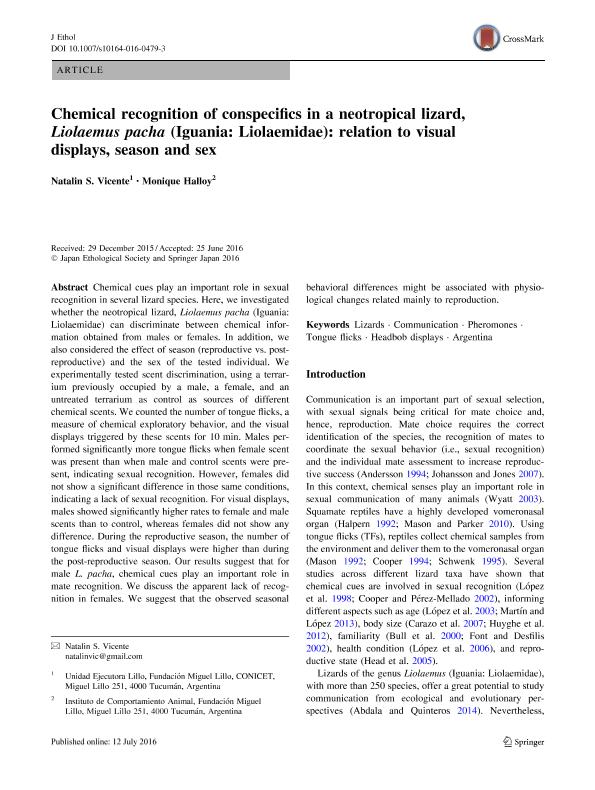Mostrar el registro sencillo del ítem
dc.contributor.author
Vicente, Natalin Soledad

dc.contributor.author
Halloy, Monique

dc.date.available
2018-08-21T19:03:00Z
dc.date.issued
2016-09
dc.identifier.citation
Vicente, Natalin Soledad; Halloy, Monique; Chemical recognition of conspecifics in a neotropical lizard, Liolaemus pacha (Iguania: Liolaemidae): relation to visual displays, season and sex; Springer Tokyo; Journal of Ethology; 34; 3; 9-2016; 329-335
dc.identifier.issn
0289-0771
dc.identifier.uri
http://hdl.handle.net/11336/56397
dc.description.abstract
Chemical cues play an important role in sexual recognition in several lizard species. Here, we investigated whether the neotropical lizard, Liolaemus pacha (Iguania: Liolaemidae) can discriminate between chemical information obtained from males or females. In addition, we also considered the effect of season (reproductive vs. post-reproductive) and the sex of the tested individual. We experimentally tested scent discrimination, using a terrarium previously occupied by a male, a female, and an untreated terrarium as control as sources of different chemical scents. We counted the number of tongue flicks, a measure of chemical exploratory behavior, and the visual displays triggered by these scents for 10 min. Males performed significantly more tongue flicks when female scent was present than when male and control scents were present, indicating sexual recognition. However, females did not show a significant difference in those same conditions, indicating a lack of sexual recognition. For visual displays, males showed significantly higher rates to female and male scents than to control, whereas females did not show any difference. During the reproductive season, the number of tongue flicks and visual displays were higher than during the post-reproductive season. Our results suggest that for male L. pacha, chemical cues play an important role in mate recognition. We discuss the apparent lack of recognition in females. We suggest that the observed seasonal behavioral differences might be associated with physiological changes related mainly to reproduction.
dc.format
application/pdf
dc.language.iso
eng
dc.publisher
Springer Tokyo

dc.rights
info:eu-repo/semantics/openAccess
dc.rights.uri
https://creativecommons.org/licenses/by-nc-sa/2.5/ar/
dc.subject
Argentina
dc.subject
Communication
dc.subject
Headbob Displays
dc.subject
Lizards
dc.subject
Pheromones
dc.subject
Tongue Flicks
dc.subject.classification
Otras Ciencias Biológicas

dc.subject.classification
Ciencias Biológicas

dc.subject.classification
CIENCIAS NATURALES Y EXACTAS

dc.title
Chemical recognition of conspecifics in a neotropical lizard, Liolaemus pacha (Iguania: Liolaemidae): relation to visual displays, season and sex
dc.type
info:eu-repo/semantics/article
dc.type
info:ar-repo/semantics/artículo
dc.type
info:eu-repo/semantics/publishedVersion
dc.date.updated
2018-08-17T16:55:26Z
dc.journal.volume
34
dc.journal.number
3
dc.journal.pagination
329-335
dc.journal.pais
Japón

dc.journal.ciudad
Tokyo
dc.description.fil
Fil: Vicente, Natalin Soledad. Consejo Nacional de Investigaciones Científicas y Técnicas. Centro Científico Tecnológico - Tucumán. Unidad Ejecutora Lillo; Argentina
dc.description.fil
Fil: Halloy, Monique. Fundación Miguel Lillo; Argentina
dc.journal.title
Journal of Ethology

dc.relation.alternativeid
info:eu-repo/semantics/altIdentifier/doi/https://dx.doi.org/10.1007/s10164-016-0479-3
dc.relation.alternativeid
info:eu-repo/semantics/altIdentifier/url/https://link.springer.com/article/10.1007%2Fs10164-016-0479-3
Archivos asociados
